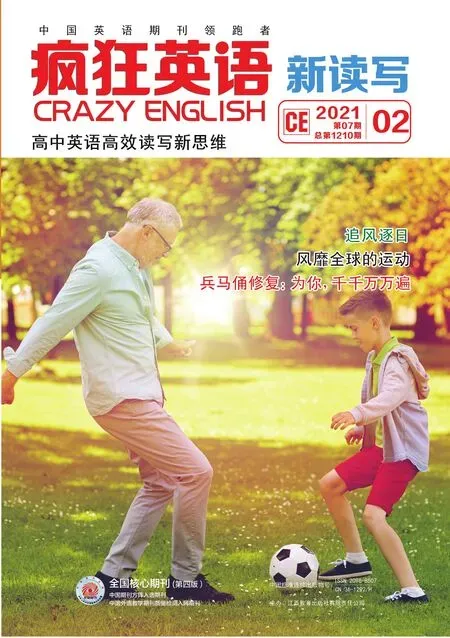Restorers piece together Terracotta Warriors
陕西 吕 品

?
难词探意
1. intervention /ˌɪntə΄venʃn/ n. 介入;干涉
2. shard /ʃɑːd/ n. (玻璃、金属等的)碎片
3. bind /baɪnd/ v. (使)联合在一起
Lan Desheng, the 52-year-old conservator-restorer is part of a specialist team piecing together and repairing the Terracotta Army, which was discovered at the Mausoleum of the First Qin Emperor in Xi'an, Shaanxi Province, in March 1974.Pointing to life-size Terracotta Warriors, Lan said, “These are pieces of history that have been vividly preserved. More than 2,000 years have slipped by, and you can still sense the huge amount of talent that went into making these figures.”
Lan said the team aims to restore the relics' original appearance by applying the principle of minimumintervention.On-site “first aid” is a key element of the work. In the tomb pits (深坑) where the relics were discovered, some 15 conservator-restorers work hard day and night. Work tables are placed in the corners of the pits, on which gray-uniformed restorers arrange different sets of tools. The Terracotta Warriors feature colorful painting and even the fingerprints of the craftsmen who made them. Using his experience, Lan can tell precisely whether the Terracotta Warriors were made by craftsmen from the Qin Court or by local artisans, as their work is quite different.

During the past 25 years, as a researcher with the Emperor Qinshihuang's Mausoleum Site Museum, Lan has restored more than 150 of the figures. He said he was anxious when he first started work in this field, even though it was his ideal job. In 1993, Lan graduated from Northwest University in Xi'an with a major in cultural heritage, and three years later, he started work on restoring Terracotta Warriors.
The conservator-restorers face a strict training program. In the first two years, Lan was not allowed to touch the relics and was told to “observe, remember and read”. His first task after his training ended was to locate fragments and search for missing parts of the figures among the piledshards.Sometimes, he was unable to find a single missing piece, and often asked his instructor when he could start to repair a complete Terracotta Warrior.
The technology used to restore the figures has changed over the years, but the fundamental methods remain the same. After fragments of the warriors and horses are collected, the restorers attempt to piece them together before using glue tobindthem. Over the decades, the restorers have become accustomed to delays and the fact that hardly anything can be done immediately. Patience is essential.
Reading
Check
1. What's the purpose of the specialist team?
A. To discover more Terracotta Warriors.
B. To decorate some Terracotta Warriors.
C. To place work tables around Terracotta Warriors.
D. To restore Terracotta Warriors' original appearance.
2. What can we know about the Terracotta Warriors?
A. They were made before Qin Dynasty.
B. They were discovered two thousand years ago.
C. They're characterized by colorful painting and fingerprints.
D. They're restored mainly by local artisans and craftsmen.
3. How did Lan feel when he first started work on restoring Terracotta Warriors?
A. Worried. B. Disappointed. C. Enthusiastic. D. Delighted.
4. Which of the following is really important for restorers?
A. Creativity. B. Patience. C. Height. D. Weight.
Language
Study
熟词生义
Lan Desheng, the 52-year-old conservator-restorer is part of a specialist team piecing together and repairing the Terracotta Army, which was discovered at the Mausoleum of the First Qin Emperor in Xi'an, Shaanxi Province, in March 1974.
piece v. 拼凑;拼合
e.g. They're piecing together a jigsaw.

